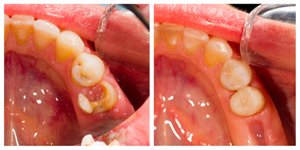Bonding
 The term bonding is used in dentistry to describe permanently attaching dental materials to teeth using dental adhesives. Bonding uses a tooth-colored material, called composite resin which can be shaped and polished to match the surrounding teeth. Bonding can be used for cosmetic purposes to improve the appearance of discoloured or chipped teeth, to close spaces between teeth, to make teeth look longer or to change the shape or color of teeth. Bonding is different than veneers, in that porcelain veneers are manufactured in a dental laboratory, require preparation and dental models, and often require at least two appointments. Bonding on the other hand, can be completed in a single visit and is done “chair-side”.
The term bonding is used in dentistry to describe permanently attaching dental materials to teeth using dental adhesives. Bonding uses a tooth-colored material, called composite resin which can be shaped and polished to match the surrounding teeth. Bonding can be used for cosmetic purposes to improve the appearance of discoloured or chipped teeth, to close spaces between teeth, to make teeth look longer or to change the shape or color of teeth. Bonding is different than veneers, in that porcelain veneers are manufactured in a dental laboratory, require preparation and dental models, and often require at least two appointments. Bonding on the other hand, can be completed in a single visit and is done “chair-side”.
As mentioned above, bonding can be used in cosmetic procedures to address the following:
- Approve the appearance of chipped teeth
- Approve the appearance of discolored or permanently stained teeth
- Close spaces between the teeth (sometimes in conjunction with orthodontics)
- Change the shape of teeth – i.e. make the teeth appear longer
Bonding can also be used to cover exposed root surfaces, which is sometimes caused by aggressive tooth brushing or grinding.
Procedure:
Typically, no preparation of the tooth surface is required, often anesthesia (freezing) is not needed. If bonding is being used to address tooth decay, then preparation of the tooth surface is required to remove the decay and often freezing is needed to make the procedure more comfortable for you. Once an appropriate color is chosen, the surface of your tooth is cleaned and primed (sometimes known as “conditioned”). A bonding agent is then brushed onto the surface of the tooth and cured with a special dental curing light. This bonding agent helps the resin material to “stick” or bond to the tooth. At this point the colored resin material is sculpted and shaped into/onto the tooth surface and again cured with the light, which hardens the resin.
After the bonding material is cured, final shaping and adjustments are made. Your bite is then evaluated and adjusted as required and the tooth is then polished.
It is important to note that resin fillings can be stained by cigarette smoke, tea, coffee and other foods and substances. To help reduce these staining effects, it is important to brush and floss your teeth regularly at home and to appoint for professional dental cleanings on a regular basis.